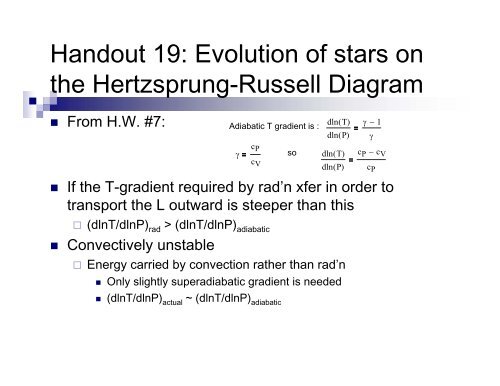Handout 19: Evolution of stars on the Hertzsprung-Russell Diagram
Handout 19: Evolution of stars on the Hertzsprung-Russell Diagram Handout 19: Evolution of stars on the Hertzsprung-Russell Diagram
- Page 2 and 3: Uniform density stellar model iscon
- Page 4 and 5: Uniform stellar modelM sunρ := con
- Page 6 and 7: Convective zones in MainSequence <s
- Page 8 and 9: Fully convective stars</str
- Page 10 and 11: Photospheric P (i.e. τ = 2/3)23τR
- Page 12: Vertical, Hayashi tracks on the H-R
<str<strong>on</strong>g>Handout</str<strong>on</strong>g> <str<strong>on</strong>g>19</str<strong>on</strong>g>: <str<strong>on</strong>g>Evoluti<strong>on</strong></str<strong>on</strong>g> <str<strong>on</strong>g>of</str<strong>on</strong>g> <str<strong>on</strong>g>stars</str<strong>on</strong>g> <strong>on</strong><strong>the</strong> <strong>Hertzsprung</strong>-<strong>Russell</strong> <strong>Diagram</strong>• From H.W. #7:• If <strong>the</strong> T-gradient required by rad’n xfer in order totransport <strong>the</strong> L outward is steeper than this (dlnT/dlnP) rad > (dlnT/dlnP) adiabatic• C<strong>on</strong>vectively unstableAdiabatic T gradient is : Energy carried by c<strong>on</strong>vecti<strong>on</strong> ra<strong>the</strong>r than rad’n• Only slightly superadiabatic gradient is needed• (dlnT/dlnP) actual~ (dlnT/dlnP) adiabaticγdln( T)dln( P)c Pso dln( T)c V dln( P)γ − 1γc P − c Vc P
Uniform density stellar model isc<strong>on</strong>vectively unstable• P = nkT number density n = c<strong>on</strong>stant dT/dP = 1/nk (dlnT/dlnP) = (P/T)(dT/dP) = 1 1 > 0.4, model is c<strong>on</strong>vectively unstable everywhere!• Ballo<strong>on</strong> moved from 1 to 2’ (figure) adiabatically i.e. no heat added• Hotter than surroundings (i.e. 2)• Less dense will rise fur<strong>the</strong>r (c<strong>on</strong>vecti<strong>on</strong>)• Carries heat energy to higher levels!
Figure: Unstable T-gradientModel,slope=1lnT12’Adiabatic,slope=0.42lnP
Uniform stellar modelM sunρ := c<strong>on</strong>stant43 ⋅π⋅ R sun 3gr ():=G⋅ρ4⋅ ⋅π⋅r 33r 2dPdr−g⋅ρ−43 ⋅π⋅G⋅ ρ2 ⋅rPR ( sun ) 0Pr ()R⌠ sun⎮⎮⌡r−4r3 ⋅π⋅G⋅ ρ2 ⋅rdPr ()10 + 4µ := µ = 0.609 n :=20 + 3Tr ()23 ⋅π⋅G⋅ ρ2 2:= ⋅⎛⎝ R sun − r 2ρµ ⋅m H1i:= ⋅Pr()i:= 0..10 r := ⋅nk ⋅i 10 R sun1 .10 7⎞⎠( )Tr iK5 .10 600 0.5 1r iR sun
C<strong>on</strong>vecti<strong>on</strong> c<strong>on</strong>tinued• The maximum adiabatic gradient is 0.4Any additi<strong>on</strong>al heat capacity will reduce this• Reducing <strong>the</strong> gradient toward zero• Forcing c<strong>on</strong>vecti<strong>on</strong> Zero gradient means no radiative fluxSources <str<strong>on</strong>g>of</str<strong>on</strong>g> heat capacity H i<strong>on</strong>izati<strong>on</strong> 6-10,000 K He i<strong>on</strong>izati<strong>on</strong> 20-50,000 K• 13.6 eV needed to i<strong>on</strong>ize• Plus (3/2)kT = 1.5 eV for <strong>the</strong> K.E. <str<strong>on</strong>g>of</str<strong>on</strong>g> <strong>the</strong> electr<strong>on</strong>Adiabatic gradient reduced to 0.1
C<strong>on</strong>vective z<strong>on</strong>es in MainSequence <str<strong>on</strong>g>stars</str<strong>on</strong>g>• H, He i<strong>on</strong>izati<strong>on</strong> create c<strong>on</strong>vective z<strong>on</strong>e justbelow <strong>the</strong> photosphere for sun The c<strong>on</strong>vecti<strong>on</strong> generates magnetic fields• Leading to sunspots, flares, active chromosphere, and x-rays Extends down to 0.8 <str<strong>on</strong>g>of</str<strong>on</strong>g> solar radius• Hotter <str<strong>on</strong>g>stars</str<strong>on</strong>g>, c<strong>on</strong>vecti<strong>on</strong> z<strong>on</strong>e shrinks Above 8000 K (F-<str<strong>on</strong>g>stars</str<strong>on</strong>g>) fully radiative• cooler <str<strong>on</strong>g>stars</str<strong>on</strong>g>, <strong>the</strong> c<strong>on</strong>vecti<strong>on</strong> z<strong>on</strong>e deepens Stars below 0.3 solar masses fully c<strong>on</strong>vective• Above 0.3 solar masses, Luminosity determinedby radiati<strong>on</strong>
C<strong>on</strong>vecti<strong>on</strong> crucial in early stellarevoluti<strong>on</strong>• Figure 9.10 shows interior κ ~ T -3.5But ~ M/R• Virial <strong>the</strong>oremIncreasingly large |dT/dr| for larger <str<strong>on</strong>g>stars</str<strong>on</strong>g>C<strong>on</strong>vecti<strong>on</strong> sets in• Stars < 5 solar mass start fully c<strong>on</strong>vectiveSun at 30 solar radii was “fully c<strong>on</strong>vective”Major blockage to luminosity is photosphere• L = 4πR 2 σT(τ=2/3) 4
Fully c<strong>on</strong>vective <str<strong>on</strong>g>stars</str<strong>on</strong>g> nearlyc<strong>on</strong>stant effective T, H- opacity• The dominant opacity at low T’s is H- Free-free and free-bound• Very str<strong>on</strong>g T-dependence (Fig. 9.10) H- needs electr<strong>on</strong>s Electr<strong>on</strong>s come from i<strong>on</strong>ized metals Saha dictatesκ κ 0 ⋅P 0.7 ⋅T 5.3• Luminosity determined by transiti<strong>on</strong> betweenc<strong>on</strong>vecti<strong>on</strong> and radiative photosphere i.e. T e = T at τ = 2/3 levelκ 0 ⋅P a ⋅Tb
Solve for P at τ = 2/3• As in homework, solve for P(τ=2/3) κ not c<strong>on</strong>stant, need to do integral Weak dependence <str<strong>on</strong>g>of</str<strong>on</strong>g> T <strong>on</strong> τ,• T can be taken out <str<strong>on</strong>g>of</str<strong>on</strong>g> integral• Solve for P (see next slide):dr⎡⎢⎣2P ph3 ⋅(a + 1)⋅gbκ 0 ⋅T e⎤⎥⎦1a+1
Photospheric P (i.e. τ = 2/3)23τR⌠⎮⌡r photosphereκρ ⋅drRb ⌠κ 0 ⋅T e ⋅⎮⌡r photosphereP a ⋅ρdrHydrostatic equil. implies23bκ 0 ⋅T e ⋅⎛⎜⎝−1g⎞⎠R⌠⋅⎮⎮⌡r photosphereρP a dP⋅dr−1 dP⋅g drdraκ 0 ⋅T e ⋅⎛⎜⎝g = c<strong>on</strong>st.−1g⎞⎠1a+1⋅ ⋅−⎛P photospherea + 1⎝⎞⎠sincedPdr ⋅drdP and Pr ( R) 01⎡2so P ph3 ⋅(a + 1)g⋅⎢bκ 0 ⋅T e⎣⎤⎥⎦a+1
Integrate adiabatic gradient fromcenter <str<strong>on</strong>g>of</str<strong>on</strong>g> star to photospheredln( T)dln( P)γ − 1γEq. (10.75)γ ⌠⋅⎮γ − 1 ⌡T cT e1 dln( T)⌠⎮⌡P cP photosphere1 dln( P)γ⋅( ln( T c ) − ln( T e ))( ln( P c ) − ln( P ph ))γ − 1exp<strong>on</strong>entiate, and solve for P at <strong>the</strong> tau = 2/3 levelγP cγ−1K'P ph K' ⋅T ewhereγγ−1T c⎡⎢⎣2solve for eff. T T e3 ⋅(1 + a)⋅GM ⋅κ 0 R 2 ⋅− ( 1+a)⋅K'⎤⎥⎦b+γ1γ−1⋅( 1+a)
Vertical, Hayashi tracks <strong>on</strong> <strong>the</strong> H-Rdiagram• Insert appropriate values Note: T c ~ M/R, P c ~ (M/R 3 )T c T e ~ R 0.06• L ~ R 2 T e4~ T e36,• T e ~ L 0.03• Tracks nearly vertical <strong>on</strong> H-R diagram (draw)• Hayashi figured this out in <str<strong>on</strong>g>19</str<strong>on</strong>g>61γγ − 12.5 K' c<strong>on</strong>st ⋅M − 0.5 ⋅R − 1.5( )T e c<strong>on</strong>st R − 2 R 1.7 ⋅ 9.551.5⋅ ⋅c<strong>on</strong>st ⋅R0.061



